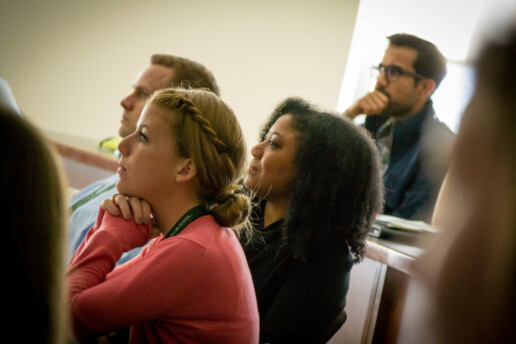Guest Post: Student Response Systems as a Tool for Formative Assessment
Guest Post: Student Response Systems as a Tool for Formative Assessment
Hannah Haksgaard
Associate Professor
University of South Dakota Knudson School of Law
Under American Bar Association Standard 314, law schools—and therefore individual law professors—are required to engage in formative and summative assessment of students. Formative assessment is assessment that occurs during the semester where students receive feedback in order to improve their performance. Although formative assessments do not need to be graded, formative assessments must include feedback that is detailed and on point. Feedback on formative assessments is most valuable if it can be provided promptly. Yet, under half of the LSSSE respondents report receiving prompt feedback from faculty “often” or “very often” on academic performance.
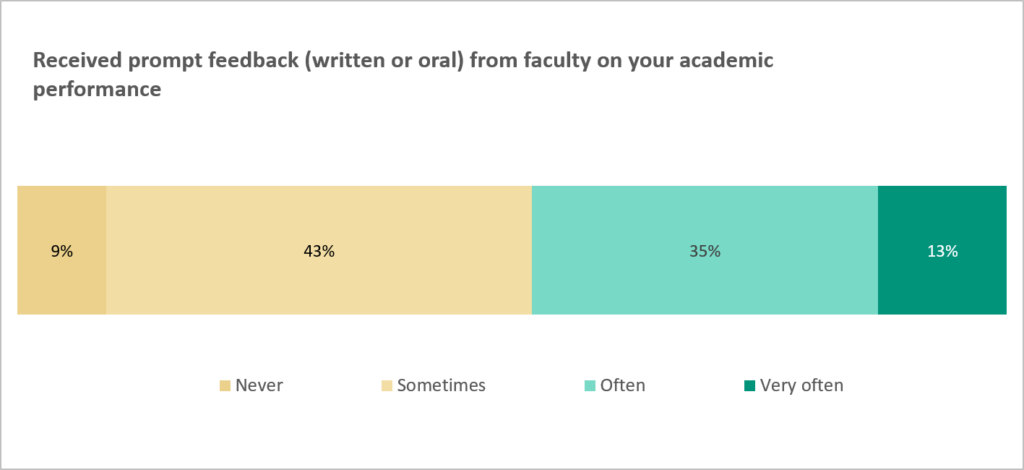
However, this student response may be undercounting formative assessments. Professors give immediate feedback in all sorts of ways that students might not recognize, such as through a Socractic dialogue in class, through brief conversations in hallways, and through feedback on group discussions during class. More formal feedback—such as graded quizzes or written comments on drafts or practice exams—is time-intensive for professors and can be especially burdensome for professors with large-enrollment courses or high service loads.
One way to provide fast feedback on student performance is to use student response systems in the classroom. Traditionally operated through hand-held clickers, student response systems are now internet-based programs that allow professors to pose multiple-choice or true/false questions on the screen and students to answer those questions on their phones or computers. Programs include Kahoot!, Mentimeter, Poll Everywhere, Socrative, Turning, and many others.
Importantly, these programs provide immediate feedback to students. Once all of the students have answered a question, the correct answer is highlighted on the screen. Plus, each student’s own device tells the student whether they were right or wrong on that question. In addition to providing feedback to students about their own individual performance, these programs show what percentage of the class chose each answer. This allows students to recognize how they are performing in comparison to peers and allows professors to modify their teaching based on the responses received.
During the COVID-19 pandemic, law professors and law students have been forced to adopt more technology in teaching and learning. Student response systems are an important way to leverage technology whether for in-person, hyflex, or online teaching. According to the LSSSE, most students feel their schools emphasize using technology in academic work.
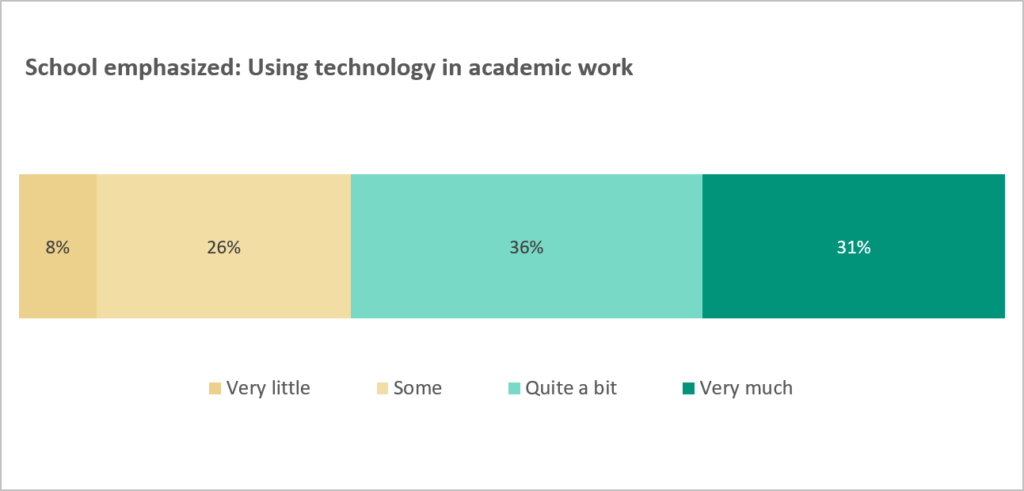
Student response systems are a way to emphasize the use of technology in the actual classroom in order to improve student learning and student participation. This is particularly important for Generation Z law students—those born between 1995 and 2010—who already make up a majority of law students, having now replaced millennials as the dominant generation in law school.
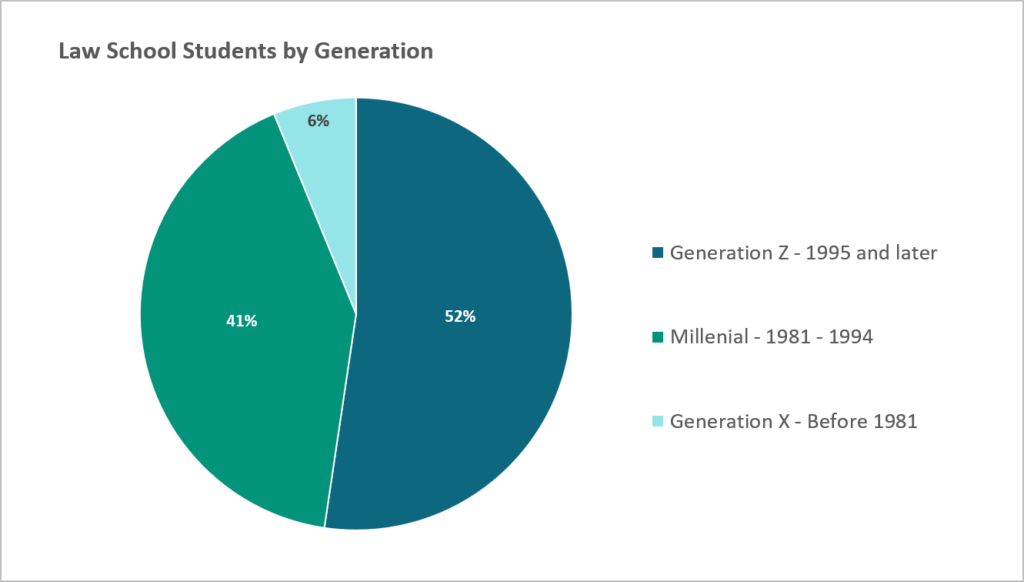
Research shows that Generation Z students expect to receive information quickly and have trouble disconnecting from cell phones.[1] Using those cell phones for in-class activities through student response systems can both engage law students and provide them the immediate feedback they seek.
This technology will never replace substantive written feedback or one-on-one meetings to discuss assignments, but student response systems are a way to supplement other assignments and types of feedback. Both students and professors benefit from formative assessment, and student response systems are an easy way to provide the immediate feedback that students need.
__
[1] Tiffany D. Atkins, #ForTheCulture: Generation Z and the Future of Legal Education, 26 Mich. J. Race & L. 115, 135 (2020).
Guest Post: A Message to White Law Faculty: Mentor Racial Minority Students
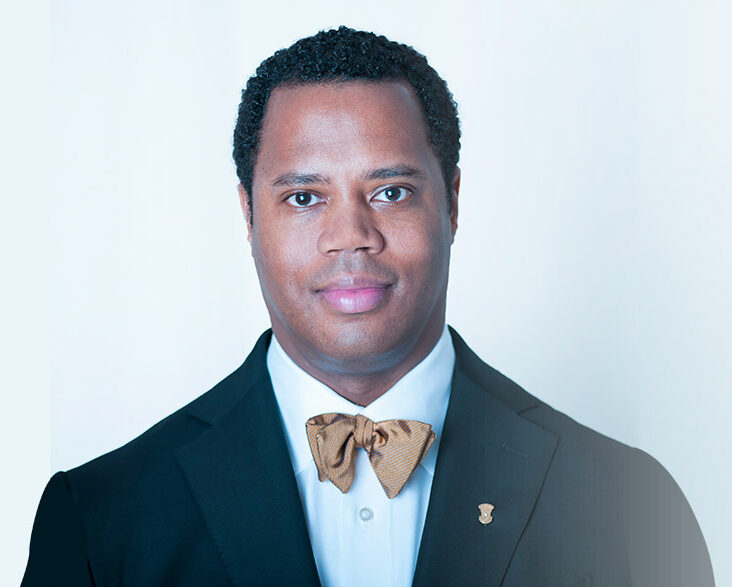 Guest Post: A Message to White Law Faculty: Mentor Racial Minority Students
Guest Post: A Message to White Law Faculty: Mentor Racial Minority Students
Gregory S. Parks
Associate Dean of Strategic Initiatives and Professor of Law
Wake Forest University School of Law
Pursuant to Law School Survey of Student Engagement’s (“LSSSE”) 2020 Diversity and Exclusion Annual Survey, there are troubling findings with regard to racial minority students’ sense of belonging and institutional support. Thirty-one percent of White students, but only 21% of Black and Native American students, feel a part of their law school community. Moreover, “women of color are more likely than men from same ethnic/racial backgrounds to feel that they are not part of the campus community.” Specifically, 34% of Black women law students felt this way. When asked if they did not feel comfortable being themselves on campus, 12% of White students agreed compared to 21% of Black, Latinx, and Native American students. Students of color are more likely to believe that their school does “very little” to ensure they are not stigmatized based on identity characteristics. Twenty-five percent of Black, 18% of Latinx, and 14% of Native American students—compared to 9% of White students—agree with the statement.

When it comes to perceptions of institutional support, 32% of White students believe that their school does “very much” to support diversity compared to 18% of Black students. Correspondingly, 26% of Black women, 14% of Black men, 8% of White women, and 6% of White men believe that their school is doing “very little” to create an environment to support diversity. In addition, 28% of White students feel like their school does “very much” to support community among students while 18% of Black students and 14% of Latinx think their school does “very little.” Not surprisingly, only 31% of Black men, 18% of Black women, 32% of Latinx men, 23% of Latinx women, 31% of White men, 26% of White women, 25% of Asian American men, 23% of Asian American women, 27% multi-racial men, and 23% multi-racial women strongly agree that they feel valued by their institution.

Faculty of color often shoulder a disproportionate amount of emotional labor in supporting students of color.[1] As such, White law faculty can and should play a meaningful role in making the law school experience one where racial minority law students feel a greater sense of belonging and institutional support. That is through mentoring. Mentoring has two distinct functions—professional and psychological. Professional mentoring aids the mentee in advancing in the workplace. Psychological mentoring seeks to bolster the mentee’s competence, effectiveness, and identity. Mentoring relationships are rooted in clear expectations, mutual respect, personal connection, reciprocity, and shared values. Within the context of cross-racial mentoring relationships, mentors must be proactive in building a foundation of mutual respect and trust. In doing so, the mentor must develop cultural awareness and sensitivity to cross-cultural issues.
As such, mentors must:
- Recognize their own privilege.
- Have a growth-mindset in the relationship.
- Empathize with their mentee where possible.
- Listen to understand when they cannot.
- Guide the mentee to their own fullest potential.
- Diversify their own viewpoints and knowledge to become more informed on issues that may not affect them.
It takes work to be a good mentor. But it pays dividends for the mentee, mentor, institution, and legal profession. Law faculty have a lot on their plate. And while it is unreasonable to think that law faculty, in the aggregate, can mentor every law student at their school, the truth is that we can likely do much better than we are doing. And given that racial minority law faculty often carry much of the emotional labor associated with supporting the most marginalized law students, White colleges can and should play a much more significant role in this effort.
___
[1] See Meera E. Deo, Unequal Profession: Race and Gender in Legal Academia (2019)(note chapters 3 and 4).
Guest Post: Bridging Global Divides in Law School and Beyond
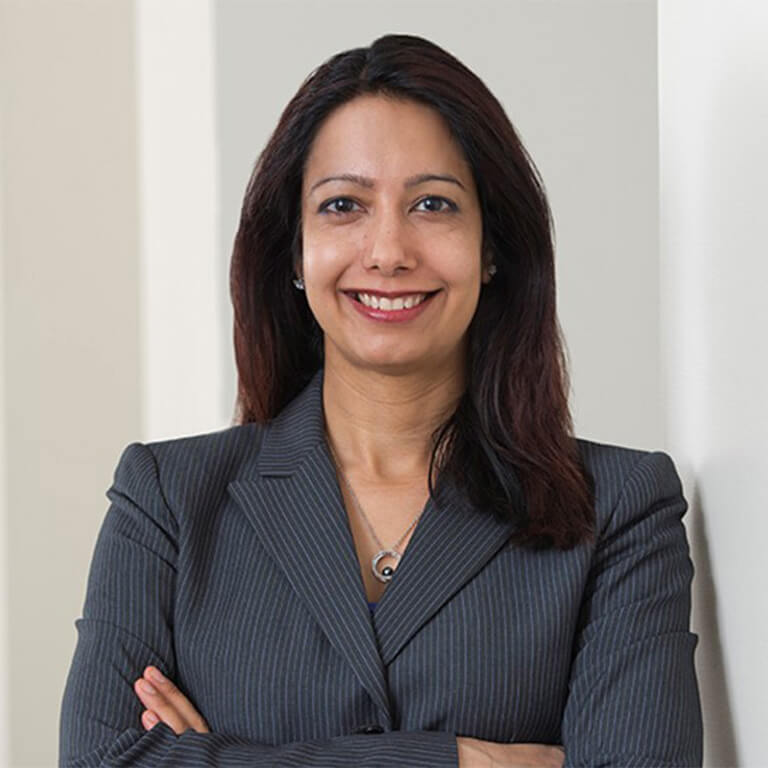 Guest Post: Bridging Global Divides in Law School and Beyond
Guest Post: Bridging Global Divides in Law School and Beyond
Shruti Rana
Professor International Law Practice
Assistant Dean of Curricular and Undergraduate Affairs
Director of the International Law and Institutions Program
Hamilton Lugar School of Global & International Studies
Indiana University Bloomington
International law is a growing and dynamic field, offering students a launching pad into a variety of careers spanning sectors from government to private practice to non-profit or advocacy work. Lawyers and advisors trained in international law have opportunities to address some of the most pressing global challenges of our time, and to build bridges through trade, business, migration, communications or capacity-building work. Careers in this field can be groundbreaking and even glamorous—notable international lawyers include Amal Clooney, Shirin Abadi, and Samantha Power.
Not surprisingly, then, international law is a popular choice for students entering law school—1L students rank international law as one of their top 10 areas of intended specialization. However, as they progress through law school, students’ interest in international careers drops steadily over time, and by graduation, international law drops down to sixteenth place in terms of student interest. These drops are especially striking for women and students of color, who initially show more interest in international law than other students yet appear similarly disillusioned by law school’s end. These trends are even more alarming for the legal profession and our nation as a whole when we consider that although “decades of research and experience prove that diversity strengthens decision-making, promotes innovation, and brings new, critical perspectives to global challenges,” women and people of color are greatly underrepresented in these global careers.
The Law School Survey of Student Engagement (LSSSE) offers some intriguing data on the question of why U.S. law students turn away from international law over time. The data also provide clues as to where the key gaps in U.S. legal education are with respect to international law, and the impact of these gaps on students’ inclusion and opportunities in law school and beyond. They offer an important starting point for leaders in legal education to consider in developing programs and perspectives that cultivate and support students interested in careers in international law. Ultimately, addressing these gaps can help create more inclusive environments for all students, as well as foster the development of the global competency skills that are increasingly critical for any legal career.
Beginning with the students themselves, LSSSE data show that students who express interest in and stick with international law as a career choice differ in striking ways from students who do neither. In terms of student diversity, there is a marked gender divide in interest in international law, with women comprising 64.8% of the students interested in pursuing international law. Overall, 7% of the women entering law school are interested in international law as compared to 5% of men. Students interested in international law are also more diverse in terms of race and ethnicity than students who are not, with Asian American students in particular significantly more interested in international law.
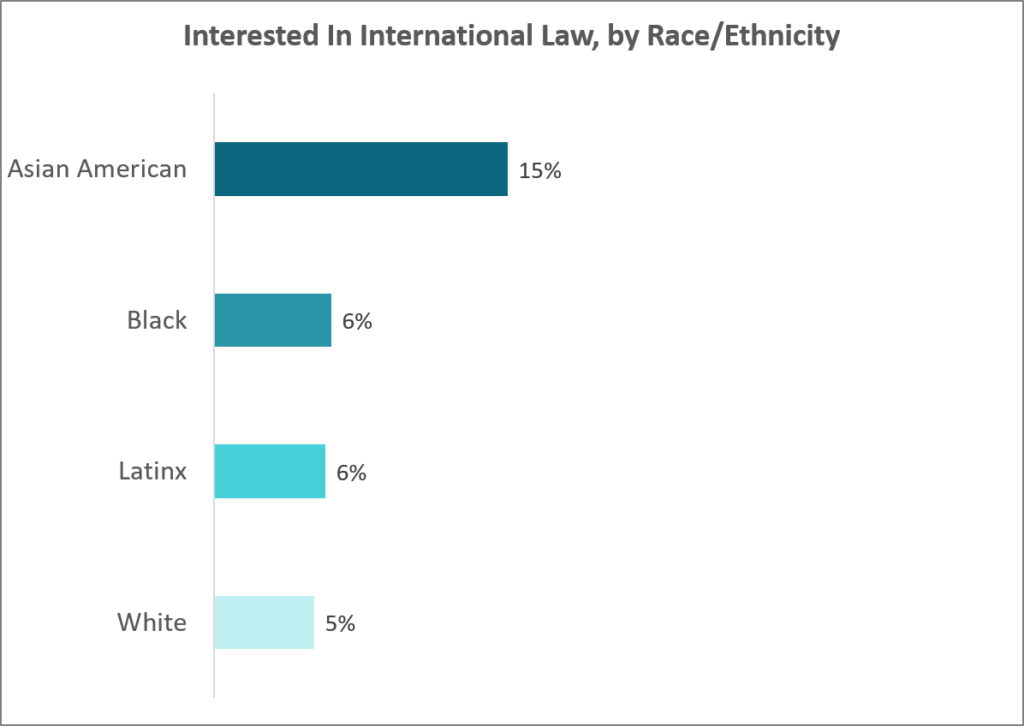
Students interested in international law are often advised to look outside of law school to develop the language, policymaking, and cultural competence skills they will need to understand the mechanisms of global governance and operate in diverse global environments. LSSSE’s data show that students interested in international law do just that. While in law school, students interested in international law are more than three times more likely to pursue a joint LLM or MA degree than students not interested in international law, perhaps to obtain global skills not traditionally taught in J.D. programs (34.8% of students interested in international law are pursuing a JD/MA, and 27.0% are pursuing a JD/LLM as opposed to 9.3% and 9.8%, respectively, of students not interested in international law). However, students who are interested in international law are about a third to one-half less likely than law students as a whole to pursue joint MBA or MS degrees. (13.5% of interested students pursue joint MBA degrees compared to 31.7% of non-interested students, and pursue MS degrees at roughly half the rate (4.5%) of students not interested in international law (8.1%). Perhaps because they must look elsewhere to develop the skills critical to international careers, students who express an interest in specializing in international law are also somewhat less satisfied with their law school experiences, as they are more likely to say that if they could start over again, they would probably not choose to attend the same law school they are now attending (18.6% of students interested in international law compared to 13.8% of students not interested in international law).
Looking beyond their law school experiences, students who express an interest in international law also show significantly different workplace preferences. As compared to students who do not express an interest in international law, they show a greater preference for government positions (15.6% vs. 10.5%), public interest groups (9.1% vs. 5.5%) and large firms over small (19.8% vs. 14.2%). They are also less interested in domestic criminal law (only 3.3% are interested working as prosecutors or public defenders, as compared to nearly 10% of students not interested in specializing in international law).
The differences delineated above correlate with and parallel larger trends in the fields of international law and global affairs. Although women make up an increasing percentage of students pursuing college and graduate education in law and the humanities, they are greatly underrepresented in professional careers in the international arena, where their perspectives and experiences are often devalued and marginalized. (See, e.g., Women in International Relations, Politics and Gender 4(1)(2008), and Do Women Matter to National Security? discussing survey results revealing the lack of women in leadership roles in these areas and in the priorities of these fields); see also The Emotional Labor of Teaching—A Feminist Critique of Teaching International Law discussing the marginalization of feminist perspectives in international law). It is likely that women both encounter these barriers to entry and general hostility to women in international affairs and institutions while in law school, and that these barriers are compounded by a lack of available mentors and visible representation in the field. The gendered impacts of these divisions are further amplified and mirrored when race, ethnicity, and the hierarchical and historical legacies of our current system of international law are added into the mix. The challenges of grappling with the colonial legacies of the current international order, or of addressing inequality through and within the field of international law, add to the already significant challenges of international careers.
It is likely that students begin (or continue) to encounter these perspectives and obstacles in law school, as international law and the language and cultural skills needed to pursue global careers are often marginalized within the legal academy. This marginalization is reflected in teaching and scholarship, the often negative perceptions of international LLM students in U.S. law schools (which LSSSE data has helped refute), and the contrasts with law schools outside of the U.S., where international law is usually a required subject. The international law arena is replete with the stories of people drawn to the field because of their experiences in the liminal, transformative spaces or social justice movements created in the wake of migration, development, war or the many other forms of global inequality—only to run directly into brick walls in law school when they encounter international law as “a discipline and a language that genuflects before the status quo” in ways that appear irreconcilable with goals such as addressing the causes and impacts of global inequality. Law schools, it appears, replicate rather than reduce the dynamics of inequality that first draw diverse students to law school, which then push them away from their careers of choice and the fields where diverse perspectives are so urgently needed.
The LSSSE data provide a valuable starting point for thinking about how we can continue to address the marginalization of international law in U.S. law schools, and its implications for students interested in international careers. We must support students in building global competency skills and the networks they need to break professional barriers, and foster an environment that equips them not to shackle but unleash the liberatory power of the law. At Indiana University, we have begun to take a number of innovative steps to address such obstacles, and create an inclusive environment focusing on the development of global skills to prepare students for careers in international law and global affairs. Our International Law and Institutions program, a joint endeavor between the Hamilton Lugar School of Global and International Studies and the Maurer School of Law, focuses on the hard and soft skills students need to pursue careers in international law and global affairs. These programs include intensive language training combined with in-depth regional experience and a focus on gaining a holistic understanding of the tools and mechanisms of global governance and civic leadership. They also include initiatives aimed at enhancing the diversity of the field of global affairs and providing the mentorship, training and networks students need to succeed in these careers. As the global challenges we face intensify and multiply, these and other efforts to enhance and prioritize the skills and experiences our students need to be “globally ready” can help build the foundations for a more inclusive and equal future.
Student Debt is a raceXgender Issue
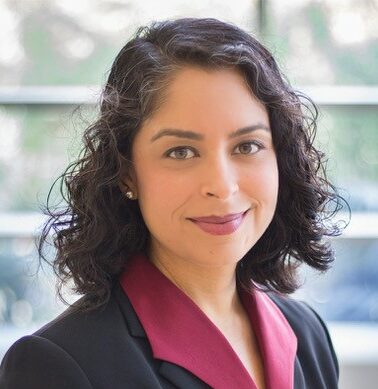 Student Debt is a raceXgender Issue
Student Debt is a raceXgender Issue
Meera E Deo, JD, PhD
Professor of Law, Southwestern Law School
Director, Law School Survey of Student Engagement
William H Neukom Chair in Diversity & Law, American Bar Foundation
Previous LSSSE publications have highlighted how the escalating costs of law school attendance have changed the landscape of legal education. Our 2020 Retrospective Report (which analyzed fifteen years of data) revealed that while in 2004, only 18% of LSSSE participants expected to owe over $100,000, by 2019 that number had skyrocketed to 39%. In 2015, LSSSE published an Annual Report stating that “the large racial and ethnic wealth disparities in the U.S. have broad implications on student debt trends,” with students of color carrying greater debt burdens than white classmates. More recently, in a publication entitled The Cost of Women’s Success, we found that women are more likely than men to borrow at the highest levels to earn a law degree—with 19% of women owing over $160,000 and 7.9% owing over $200,000 (compared to 14% and 5.5% of men, respectively).
Given the increasing costs of legal education overall, as well as ongoing gender disparities and racial/ethnic disparities, it should be no surprise that there are also marked raceXgender disparities. My previous research has introduced the concept of raceXgender bias, explaining “how the combination of these two particular identity characteristics create not just additive but compound effects in the personal and professional lives of women of color.” Applying that intersectional framework to the context of student debt, it becomes clear that we must think of increasing student loans as a raceXgender issue.
Not only do women as a whole carry greater debt burdens than men, but these gender disparities remain constant within every racial/ethnic group. In other words, women of color shoulder a disproportionate share of the debt burden in legal education. A full 16% of Latinas and 14% of Black women expect to graduate with more than $200,000 in student loans, compared to 12% of Latino men, 7.3% of Black men, and smaller percentages of those from other racial/ethnic groups. No Native American respondents expect to owe over $200,000 to complete their education; however, consistent with gender disparities in other racial/ethnic groups, a full 15% of Native American women carry over $160,000 in student loans, compared to just 7.1% of Native American men.
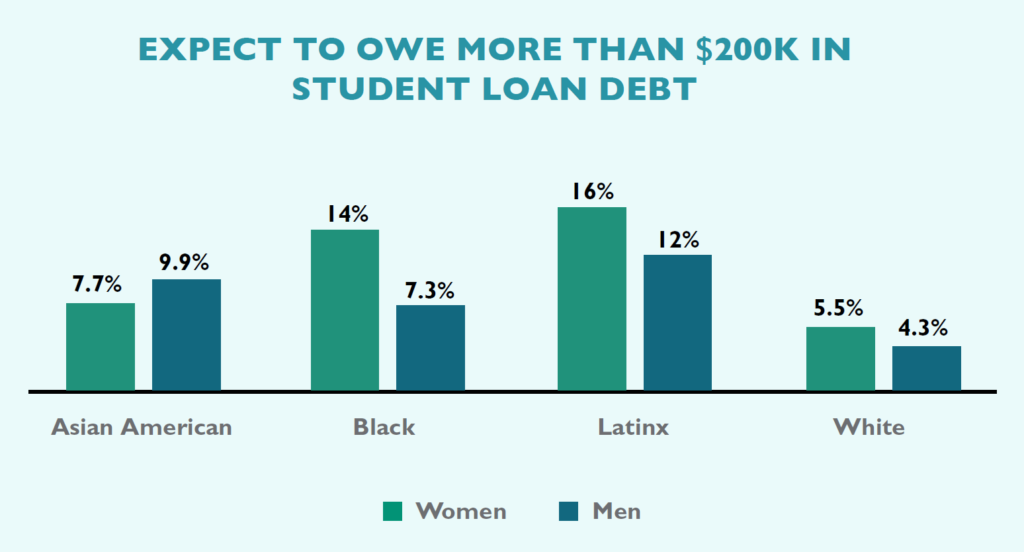
Legal education must address student loan disparities—not only as a racial justice issue, not only as a critical women’s issue, but also as an issue of raceXgender bias.
Guest Post: Correcting the Diversity Skills Disconnect Using LSSSE Data
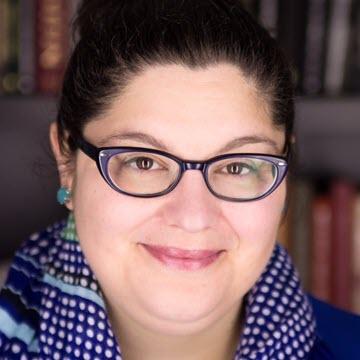 Guest Post: Correcting the Diversity Skills Disconnect Using LSSSE Data
Guest Post: Correcting the Diversity Skills Disconnect Using LSSSE Data
Nicole P. Dyszlewski
Head of Reference, Instruction, & Engagement
Roger Williams University School of Law
There is a disconnect within legal academia about diversity, inclusion, racism, sexism, equality, power, and social justice issues in law. There is a disconnect between faculty attitudes about the value of teaching diversity skills and the actual inclusion of diversity skills in law school doctrinal classes. This disconnect has existed for years. It exists in the hallways and the cafeterias, but it looms largest over law school classrooms. The disconnect has taken on a new urgency in the year since the murder of George Floyd (and countless other Black victims of police violence), since a year’s worth of historic protests against anti-Black violence, and since the demands made by student groups at many of our schools to change the status quo. Today I want to share some of my own experiences with this disconnect, talk about how LSSSE data can be used to inform our institutions about the disconnect, and introduce a book I have been working on in the last few years to help provide resources for those who want to teach 1L students about the roles that diversity, equity, and social justice play in shaping and practicing the law.
I have very rarely heard a law professor say that teaching about social justice, equity, and the needs of a diverse society is not important or not a good fit for the law school curriculum. While these naysayers exist, they seem to be very few in number. Most law professors I have encountered in person, in my networks, on law Twitter, or through their scholarship seem to think these issues are relevant if not critical in law. In fact, the council of the ABA's Section of Legal Education and Admissions to the Bar recently approved a revision to law school accreditation standards which would require schools to “provide training and education to law students on bias, cross-cultural competency, and racism: (1) at the start of the program of legal education, and(2) at least once again before graduation.” (See the current Notice and Comment).
 Despite wide agreement among faculty that these topics are critical in the law school curriculum, I have also observed a NIMBY-ism. I have heard faculty from several schools explain that there is too much content to cover in the semester and they can’t possibly add diversity issues to their class. I have heard professors say that diversity, racism, sexism, social justice, and similar issues don’t naturally come up in the class they teach so it wouldn’t make sense to add them. I have heard professors say they will not use any hypos or examples which confront these issues because they feel that the discussion would be too difficult to manage and take away from the “real” learning. While many of us agree that these topics are critical to the law school curriculum, fewer faculty find them critical to their own classes and their own teaching practice. There is a disconnect here between what we espouse and what we do.
Despite wide agreement among faculty that these topics are critical in the law school curriculum, I have also observed a NIMBY-ism. I have heard faculty from several schools explain that there is too much content to cover in the semester and they can’t possibly add diversity issues to their class. I have heard professors say that diversity, racism, sexism, social justice, and similar issues don’t naturally come up in the class they teach so it wouldn’t make sense to add them. I have heard professors say they will not use any hypos or examples which confront these issues because they feel that the discussion would be too difficult to manage and take away from the “real” learning. While many of us agree that these topics are critical to the law school curriculum, fewer faculty find them critical to their own classes and their own teaching practice. There is a disconnect here between what we espouse and what we do.
It is our students, particularly our students from marginalized and underrepresented communities, who are paying the price for this disconnect. As LSSSE Director Meera Deo stated in a recent report, “what the data unequivocally show, is that those who are most affected by policies involving diversity—the very students who are underrepresented, marginalized, and non-traditional participants in legal education—are the least satisfied with diversity efforts on campuses nationwide.”
There isn’t much data on the prominence of diversity or social justice within most law schools’ curricula. Even if at an individual level we are successful at teaching diversity and diversity skills in our classrooms, how mainstream is this practice? Is it effective? Some schools may include questions on diversity, diversity skills, and inclusion in annual faculty activity reports or end of the semester student evaluations. Some (Many? Most?) schools do not. In 2020, LSSSE introduced a set of supplemental questions focused on diversity and inclusion. At my own institution we are waiting for this year’s supplemental LSSSE data to begin analyzing it to inform us on the student perspectives of diversity in the curriculum. We have also been in discussions about how to supplement the LSSSE data with additional surveys of students’ perspectives.
The LSSSE Diversity and Inclusiveness supplemental module includes questions about how much the student feels that their coursework has emphasized developing the skills necessary to work effectively with people from various backgrounds, learning about other cultures, discussing issues of equity or privilege, respecting the expression of diverse ideas, and recognizing your own cultural norms and biases. This data is integral to assessing your institution, your curriculum, and also your institution’s commitment to diversity. Engaging with the LSSSE data on diversity and inclusion is one place for law schools to start. LSSSE Director Deo cautions, “while institutions have been touting a commitment to equality with broad diversity statements and written policies supporting equal opportunities, traditional insiders see these words as doing the work while underrepresented students pay the price for ongoing inequities.”

Over the last year dozens of law schools have re-focused their diversity and inclusion efforts, planning, programming, and assessment. At my institution we have been in discussions throughout the Spring semester as we plan to use this forthcoming data to assess an item in our strategic plan for diversity and inclusion in which we vowed to “[a]ddress inequality and social justice issues in courses across the curriculum, identify teaching materials that facilitate consideration of those issues, and provide students the opportunity, where appropriate, to evaluate faculty members on the effectiveness of their efforts.” For this assessment, the LSSSE data will be one tool in our toolbox.
Another step law schools must take is to fully integrate diversity and diversity skills into the foundational curriculum. Kimberly M. Mutcherson, Co-Dean & Professor of Law at Rutgers Law School, gets right to the heart of the matter in her Foreword to LSSSE’s 2020 Annual Report, Diversity and Exclusion, calling on law schools “to re-visit their curricula and note how they fail to adequately grapple with law as a tool of oppression (past and present).”
A few years ago, a group of colleagues and I began a project to solicit and compile practical resources for professors who are trying to rework the curriculum in the way Dean Mutcherson describes. This spring, we published a book titled Integrating Doctrine and Diversity: Inclusion and Equity in the Law School Classroom. It is a collection of essays with practical advice, written by faculty for faculty, on specific ways to integrate diversity, equity, and inclusion into the first year law school curriculum. It contains essays, organized by 1L class topics, on both pedagogical approaches and case studies. The essays contain thoughtful, meaningful engagement from faculty who’ve reflected consciously on how to address diversity in the classroom. The book also contains a cross-curricular chapter addressing these issues from a broader perspective. The book is a response to students who are seeking more from their classes, but it is also a response to the faculty who want to change but need guidance and inspiration on how to begin.
As legal education considers the wisdom in revising our accreditation standards, and as we enjoy our summer of writing and preparing for fall classes, I would ask that we consider the next steps towards diversifying our curricula and fixing the disconnect between our teaching and our institutional goals. Let this be the summer of reviewing LSSSE data, auditing our syllabi for diverse voices, supplementing our casebooks with readings that seek to decolonize the law, re-considering our pedagogical practices, and making room for the lived experiences of our students in our classrooms.






